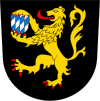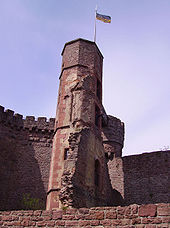Dilsberg
|
Dilsberg
City of Neckargemünd
|
|
|---|---|
| Coordinates: 49 ° 23 ′ 57 ″ N , 8 ° 50 ′ 9 ″ E | |
| Height : | 288 m above sea level NHN |
| Residents : | 2098 (Jun 30, 2009) |
| Incorporation : | 1st January 1973 |
| Postal code : | 69151 |
| Area code : | 06223 |

Dilsberg is a district of the city of Neckargemünd in the Rhine-Neckar district of Baden-Württemberg and is located in the Neckartal-Odenwald nature reserve . The mountain fortress Dilsberg forms the historical center of the village and is located on the top of a mountain surrounded by a loop of the Neckar .
geography
The historic center of Dilsberg, that is the Dilsberg mountain fortress , is visible from afar above the Neckar valley on a ridge in a river bend . Following a side valley incision, elongated, newer development adjoins the town center to the southeast. The place has 2126 inhabitants (as of June 30, 2004). In addition to the main town, the local area consists of the districts Neuhof, Dilsbergerhof, Blumenstrich and Rainbach.
history
Roman finds in the Dilsberg district suggest that the Dilsberg used to be a signaling station for the Romans . This is evidenced by finds like those of an Honorius gold coin and parts of a Mercurius relief. Since 988 the Dilsberg belonged to the diocese of Worms as part of the Wimpfener Bannforst . In the middle of the 12th century, the Worms bishops cleared parts of the mountain. This is where the Dilsberg mountain fortress was created , which was first mentioned in 1208 and came to the Electoral Palatinate via the Counts of Lauffen and the Lords of Dürn in 1300 , and whose early history is essentially shared by the Burgweiler.
In 1347 Dilsberg was raised to town. In the 15th century, the city was the seat of the Electoral Palatinate Office Dilsberg as the administrative authority for the surrounding villages. In the Thirty Years War Dilsberg was besieged by Tilly in 1621 and surrendered in 1622 after the conquest of Heidelberg. After the further turmoil of the war, Dilsberg came back to the Electoral Palatinate in 1648 and was expanded as a garrison . The place survived the conquest by the troops Ezéchiel de Mélacs in the Palatinate War of Succession in 1690 and also fought back a French revolutionary army in 1799.
In 1803 the place came to Baden . The mountain fortress initially served as a state prison as well as a lockup for students of the University of Heidelberg , but was released in 1826 to demolish and to the partial restoration in 1895 used as a quarry. In 1919 the Communist Party of Germany (KPD) met in Dilsberg as part of its illegally held Heidelberg party congress . The youth hostel was built in 1934 .
Around 1964 it was connected to the city of Neckargemünd's water supply . In 1967 there was a redevelopment plan for the historic town center. On January 1, 1973 the incorporation to Neckargemünd was completed.
coat of arms
The blazon of the former coat of arms of the municipality of Dilsberg, which was independent until 1973, reads: In black a red armored and red-tongued golden lion, in the front paws holding a shield roughened in blue and silver.
Attractions
The medieval mountain fortress Dilsberg survived several armed conflicts unscathed, but is still in ruins today, as the castle was temporarily released for demolition in the 19th century and served as a quarry. The castle is divided into a fore and a main castle. The outer bailey included the disabled barracks (now a garden), the tithe barn , the stables with the fruit store and the commandant's house. In the courtyard of the main castle which was Palas , only a cellar and a hexagonal staircase tower is obtained from the. The 16 meter high curtain wall used to surround the entire main castle before the eastern and southern parts were demolished. The castle also includes the old prison of Heidelberg University , a castle well with a depth of about 46 meters and a castle tunnel with a total length of 78 meters. There are numerous historical residential buildings within the fortress area.
The Catholic St. Bartholomew Church was built around the year 1380. It was consecrated to Saint Oswald, who like Saint Margarethe was one of the fourteen helpers in need.
There has been evidence of a reformed congregation in Dilsberg since 1566. It flourished until the Thirty Years War, but never recovered from the troubled years and sank into poverty after 1705. Today's Evangelical Church was built from 1871 to 1873 according to plans by church building inspector Hermann Behaghel with the great commitment of the rural church community.
Culture
After the Dilsberg municipal council was only allowed to lift the night watch in 1878, the custom revived in 1923 when the night watchmen " ring in " the New Year . After the night watchman has blown the horn twelve times , the men join in the following song:
- Listen, people, and let me tell you:
- Our bell has struck twelve.
- The old year has passed
- the new has started.
- We wish you all the same
- the poor as the rich,
- we wish you all
- Happy New Year Praise the Lord God.
Personalities
- Rainer Ohlhauser (* 1941), soccer player
- Herbert Rudolf Bossler (* 1907; † 1999), shipping entrepreneur , was born in Rainbach, a former hamlet of Dilsberg
Mention in the literature
The American writer Mark Twain describes in his travel story A Tramp Abroad (in German: Stroll through Europe ) the visit to Dilsberg as part of a raft trip from Heilbronn to Heidelberg .
Individual evidence
- ^ Federal Statistical Office (ed.): Historical municipality directory for the Federal Republic of Germany. Name, border and key number changes in municipalities, counties and administrative districts from May 27, 1970 to December 31, 1982 . W. Kohlhammer, Stuttgart / Mainz 1983, ISBN 3-17-003263-1 , p. 475 .
literature
- Günther Herrman: Dilsberg 800 - a reading book for the castle anniversary. A fun journey through history . City of Neckargemünd, Neckargemünd 2008, ISBN 978-3-931033-36-1 .
- Rüdiger Lenz: winery and sub-office Dilsberg. Development of a regional administrative authority within the scope of the Palatinate territorial policy on the lower Neckar . Kohlhammer, Stuttgart 1989, ISBN 3-17-010526-4 , ( Publications of the Commission for Historical Regional Studies in Baden-Württemberg Series B 115), (At the same time: Heidelberg, Univ., Diss., 1988).
- Wolfgang Seidenspinner: Dilsberg, City of Neckargemünd . In: Heidelberg, Mannheim and the Rhine-Neckar area . Theiss, Stuttgart 1999, ISBN 3-8062-1407-7 , ( Guide to archaeological monuments in Germany 36).
- Stefan Wiltschko: Castle and community Dilsberg. Outlines from the story . Heidelberger Verlags-Anstalt, Heidelberg 1994.
- Stefan Wiltschko: Castle Fortress Dilsberg. Guide through the castle complex . Braus, Heidelberg 2000, ISBN 3-926318-80-5 , ( Guide to State Palaces and Gardens ).
Web links
- Fortress and community Dilsberg, in Thomas Juelch: Heidelberg and the Electoral Palatinate
- Private website about Dilsberg in cooperation with the local council
- Aerial photos of Dilsberg
- 3D model of the Dilsberg urban complex










